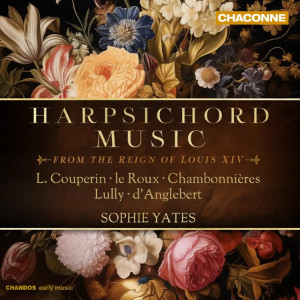
Harpsichord Music from the Reign of Louis XIV
Sophie Yates (harpsichord)
rec. 2024, Hassage Manor, Norton Saint Philip (near Bath), UK
Chandos Chaconne CHAN 0830 [76]
Sophie Yates is not unfamiliar with the Chandos microphones: this may be her fifteenth solo album. There is, of course, an enormous amount of repertoire at her disposal, and she has already investigated a wide variety. Here she returns to the French Court. She has selected Andrew Garlick’s warm-toned copy of the Vaudry harpsichord from c.1680 (which can be seen at the Victoria and Albert Museum), with a double manual and a good range of four-and-a-half octaves. She recorded the programme in the intimate space of the 17th-century Hassage Manor in Somerset, a lovely house well suited to music originally performed in small, intimate apartments.
We get here a fine overall view of keyboard music from the period about 1650-1710. The earliest pieces may well be those by Louis Couperin, but his very famous teacher Chambonnières is also featured. His four short pieces here were found in two manuscripts, called rather dryly MS Druent (c.1695) and MS Bauyn (1658-1706). There is a Courante, two Sarabandes, two Chaconnes and a Gigue – one should not be too surprised that they are dance forms. Chambonnières was also a fine dancer (as was Lully a few years later in Louis XIV’s reign), and dance was integral to court entertainment. The king himself was also quite expert. The booklet beautifully reproduces the fine hand of the manuscript compiler in the two connected Chaconnes.
The first work on the disc is by Jean Henri d’Anglebert, another pupil of Chambonnières. His Third Suite is a good example of the genre. The opening Prelude, ‘non mesuré’, is quite elaborate. There follows an Allemande, a Courante with its double or variation, and a second Courante, then a Sarabande marked ‘grave’ and a Gigue. I have played pieces by d’Anglebert for some years, so I will admit that I find his style somewhat too complex and even mannered. Sophie Yates, however, adds an especially wonderful level of sophistication.
The Bauyn manuscript includes Louis Couperin’s three works recorded here. The moving Tombeau de M.Blancrocher is actually in memory of a leading lute player of the day, Charles Fleury, who died in 1652 by falling downstairs. Such pieces were not unusual, and performances are mostly marked by a rhythmic rubato resulting in an unmeasured pulse. The Pavanne, in the unusual key of F-sharp minor, may well be another Tombeau in memory of a lutenist, one Ennemond Gaultier. If you know any Froberger (or have played some, as I have), you will easily recognise in the Prelude in imitation of Froberger how remarkably Couperin manages to incorporate typical Froberger-like melodic fragments and harmonies, especially in the opening bars. He also includes a typical section in the middle, in compound time.
Jean-Baptiste Lully was also a dancer, and an even finer and more versatile composer. We hear his Chanconne d’Amadis. It is worth remembering that this form offered the composer an opportunity to use a repeated harmonic pattern, and to show his imagination in how to ornament or treat it. This piece comes from the fascinating Le Manuscrit Caumont Clavecin (which also includes Les Cloches). It is a transcription of an exuberant orchestral work from Lully’s Amadis, tragédie en musique of 1684.
Bookending the disc is another Suite, this time by Gaspard le Roux, of whom little is definitely known. It consists of an unmeasured Prelude, an Allemande marked grave, and a lively Courante and a Chaconne which builds in virtuosity.
Perhaps this disc is a little niche, but it is certainly one to investigate for anyone with an interest in keyboard music at the height of the French Baroque.
Gary Higginson
Buying this recording via a link below generates revenue for MWI, which helps the site remain free



Contents
Jean Henri d’Anglebert (1629-1691)
1-7 Troisième Suite in D minor (published 1689)
Nicolas Lebègue (c. 1631-1702)
8 Allemande de M.? Le Begue (MS Druent)
Jacques Champion de Chambonnières (c. 1601/1602-1672)
9-12 Courante, Sarabande, Gigue and Chaconne (MS Bauyn)
Anonymous
13 Dance Angloise (MS Druent)
Louis Couperin (c.1626-1661)
14 Tombeau de M.Blancrocher (1652)
Nicolas Lebègue
15 Les Cloches
Jean-Baptiste Lully (1632-1687)
16 Chanconne d’Amadis
Louis Couperin
17 Prélude à l’imitation de M.Froberger
18 Pavanne
Gaspard le Roux (c.1670-1707)
19-22 Cinquième Suite (published 1705)

















